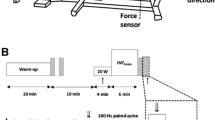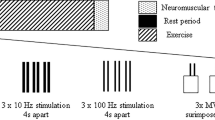Abstract
The effects of fatigue upon the torque-velocity (T-ω) relationship in cycling were studied in 11 subjects. Fatigue was induced by short exhausting exercise, on a cycle ergometer, consisting of 4 all-out sprints without recovery. The linear (T-ω) relationship was determined during each all-out sprint, before, during and after the exhausting exercise. The kinetics of the T-ω relationship had permitted the study of the recovery of optimal torque, optimal velocity and their corresponding maximal power outputs (P max), 30 s or 1 min after the short exhausting exercise. Fatigue induced a parallel shift to the left of the T-ω relationship which was partly reversed by a parallel shift to the right during recovery. After 30 s recovery optimal velocity, optimal torque and P max were slightly lower than the corresponding values before the exhausting exercise; after 1-min optimal velocity and optimal torque had recovered 99% and 97% of their initial values. These mechanical data suggested that the causes of exhaustion were processes that allowed fast recovery of both optimal velocity and optimal torque.
Similar content being viewed by others
Author information
Authors and Affiliations
Additional information
Accepted: 22 February 1999
Rights and permissions
About this article
Cite this article
Buttelli, O., Vandewalle, H. & Jouanin, J. Recovery of the torque-velocity relationship after short exhausting cycling exercise. Eur J Appl Physiol 80, 249–251 (1999). https://doi.org/10.1007/s004210050589
Issue Date:
DOI: https://doi.org/10.1007/s004210050589




